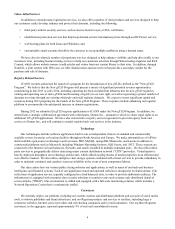Enom 2012 Annual Report Download - page 19
Download and view the complete annual report
Please find page 19 of the 2012 Enom annual report below. You can navigate through the pages in the report by either clicking on the pages listed below, or by using the keyword search tool below to find specific information within the annual report.14
Poor perception of our brands, business or industry could harm our reputation and adversely affect our business, financial
condition and results of operations.
Our business is dependent on attracting a large number of visitors to our owned and operated websites and our network of
customer websites and providing leads and clicks to our advertisers and customers, which depends in part on our reputation
within the industry and with our customers. Because our business is transforming traditional content creation models and is
therefore not easily understood by casual observers, our brands, business and reputation are vulnerable to poor perception. For
example, perception that the quality of our content may not be the same or better than that of other published Internet content,
even though baseless, can damage our reputation. We are frequently the subject of unflattering reports in the media about our
business and our model. While disruptive businesses are often criticized early on in their life cycles, we believe we are more
frequently targeted than most because of the nature of the business we are disrupting-namely the traditional print and
publication media as well as popular Internet publishing methods such as blogging. Any damage to our reputation could harm
our ability to attract and retain advertisers, customers and freelance creative professionals who create a majority of our content,
which would materially adversely affect our results of operations, financial condition and business. Furthermore, certain of our
owned and operated websites, such as LIVESTRONG.com and eHow, as well as some of the content we produce for our
network of customer websites, are associated with high-profile experts to enhance the websites' brand recognition and
credibility. In addition, any adverse news reports, negative publicity or other alienation of all or a segment of our consumer
base relating to these high-profile experts would reflect poorly on our brands and could have an adverse effect on our business.
For example LIVESTRONG.com is a licensed trademark from the LIVESTRONG Foundation, which is the charitable
foundation created by Lance Armstrong to promote cancer awareness and healthy lifestyles. While recent negative publicity
surrounding Lance Armstrong has not had a material impact on the performance of LIVESTRONG.com to date, there can be
no assurance that these events will not have a material adverse effect on its traffic and monetization in the future.
We rely primarily on creative professionals for a majority of our online content. We may not be able to attract or retain
sufficient creative professionals to generate content on a scale or of a quality sufficient to grow our business. As we do not
control those persons or the source of content, we are at risk of being unable to generate interesting and attractive features
and other material content.
We rely primarily on freelance creative professionals for the content that we distribute through our owned and operated
websites and our network of customer websites. We may not be able to attract or retain sufficient qualified and experienced
creative professionals to generate content on a scale or of a quality sufficient to grow our business. For example, our premium
video initiatives may require the engagement of producers, contributors, talent, editors and filmmakers with a specialized skill
set, and there is no assurance that we will be able to engage such specialists in a cost-effective manner or at all. Furthermore, as
we develop new content formats to meet changing consumer demand, we may not offer the volume of traditional content
assignments that our creative professionals have grown accustomed to, and some of our creative professionals may seek
assignments elsewhere or otherwise stop producing content for us. In addition, our competitors may attempt to attract members
of our freelance creative professional community by offering compensation that we are unable to match. We believe that over
the past four years our ability to attract and retain creative professionals has benefited from the weak overall labor market and
from the difficulties and resulting layoffs occurring in traditional media, particularly newspapers. We are uncertain whether this
combination of circumstances is likely to continue and any change to the economy or the media jobs market may make it more
difficult for us to attract and retain freelance creative professionals. While each of our freelance creative professionals is
screened through our pre-qualification process, we cannot guarantee that the content created by our creative professionals will
be of sufficient quality to attract users to our owned and operated websites and to our network of customer websites. In
addition, in the vast majority of cases we have no written agreements with these persons which obligate them to create articles
or videos beyond the one article or video that they elect to create at any particular time and we have no ability to control their
future performance. As a result, we cannot guarantee that our freelance creative professionals will continue to contribute
content to us for further distribution through our owned and operated websites and our network of customer websites or that the
content that is created and distributed will be sufficient to sustain our current growth rates. In the event that these creative
professionals decrease their contributions of such content, we are unable to attract or retain qualified creative professionals or if
the quality of such contributions is not sufficiently attractive to our advertisers or to drive traffic to our owned and operated
websites and to our network of customer websites, we may incur substantial costs in procuring suitable replacement content,
which could have a negative impact on our business, revenue and financial condition.
























